Archive for the ‘women hair loss’ Category
Tuesday, October 1st, 2013
What is the difference between female and male hair loss? Female hair loss is not as common as male hair loss. Male hair loss is known as male patterned baldness. Female hair loss usually doesn’t lead to complete baldness like male hair loss. Female hair loss could be known more as thinning.
Female Patterned Baldness (FPB) touches the entire scalp, unlike Male Patterned Baldness (MPB). For female hair loss the donor hair in the back is not protected like it is for males. After the age of 50, most men have some degree of hair loss.
Women can benefit from hair restoration, so they can restore their hair in the balding areas. For women, the most important factor in receiving a hair transplant is the amount of hair they have in the donor area. If a women’s hair loss is similar to a male’s hair loss, the woman will be a better candidate for a hair restoration procedure.

Women’s expectations will not be the same as men’s expectations. A good hair transplant surgeon should be aware of that and set realistic expectations. If a man is bald, having 50% of his original density might seem like a dream come true. For a woman however, having 50% density will most likely not be enough.
If a woman goes to see a hair transplant surgeon wanting 100% of her hair density back, the surgeon should be honest with her and tell her that she might not receive the 100% density back in just one surgery. In order for a woman to be a candidate for hair restoration, the hair transplant surgeon should look at the different factors that will determine the candidacy for the woman.
The different factors that need to be determined for women regarding hair restoration surgery is the limited balding area, the donor/recipient mismatch, and realistic expectations.
- The Limited Balding Area means that the area that the woman’s head is balding shouldn’t be all over the head, it should just be in a certain area.
- The donor/recipient mismatch means that the donor hair on the back of the woman’s head should be in a much better quality than the area’s that are balding.
- Realistic expectations mean that the hair transplant surgeon should make sure the woman understands the reality of a hair transplant surgery. The hair transplant surgery only moves hair from one area to another area that needs to be covered.
Overall, the final factor that a women needs to consider before having a hair restoration procedure is making sure the hair restoration surgeon is experienced in handling hair restoration procedures in women. A well knowledgeable and experienced surgeon will do the best job possible to help the woman reach the goal that they want to reach.
Tags: female hair loss, female patterned baldness
Posted in Dr. Parsa Mohebi, Hair Loss, women hair loss | No Comments »
Tuesday, September 10th, 2013
A miniaturization study is very important in order to know what the level of hair miniaturization is for the patient. Using this method, the Doctor can also know what rate the hair is thinning. The hair restoration surgeon can compare the hair loss area to the individual’s normal healthy hair. The hormone that causes hair to thin is known as the DHT hormone. The hairs that are not affected by the DHT hormone are in the donor area, which includes the hairs on the sides and back of the head.
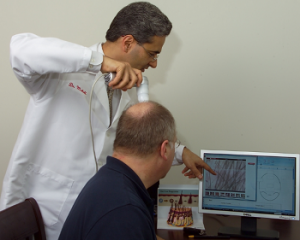 Hair goes through a cycling phase, where a hair shaft falls and after a few weeks another one begins to grow from the same follicle. In most cases the cycle won’t pass 20% of the hair shafts in any area. Hair loss will become active because the follicles of the hair go through a growth cycle. During the growth cycle process, there are resting intervals where the hairs slowly start to get thinner and miniaturization occurs. Only a small percentage of the hairs will be in resting phase. Miniaturization occurs when the hair shaft is no longer as thick as it was before. At that time the hairs become very thin and it is not seen to the naked eye. Hair goes through a cycling phase, where a hair shaft falls and after a few weeks another one begins to grow from the same follicle. In most cases the cycle won’t pass 20% of the hair shafts in any area. Hair loss will become active because the follicles of the hair go through a growth cycle. During the growth cycle process, there are resting intervals where the hairs slowly start to get thinner and miniaturization occurs. Only a small percentage of the hairs will be in resting phase. Miniaturization occurs when the hair shaft is no longer as thick as it was before. At that time the hairs become very thin and it is not seen to the naked eye.
When the hair restoration surgeon is doing the microscopic evaluation, he or she will determine the percentage of miniaturized hairs by area. When they look under the microscope at areas of the head, they estimate the percentage of miniaturization. If there is any part of the head that is over 20% miniaturization, that would be considered abnormal. That area would need to be evaluated and treated because that shows the surgeon that the patient will eventually lose the hair in that area. At that time the hair restoration surgeon will explain the different options that you have to prevent hair loss. If your hair loss has been active for a while, the Doctor can also recommended that you have a hair restoration procedure.
Tags: DHT Hormone, microscopic evaluation, miniaturization
Posted in Hair Loss, hair transplant, men hair restoration, women hair loss | No Comments »
Friday, January 25th, 2013
SCALP Tattooing
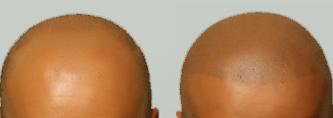 SMP- scalp micro pigmentation is a cosmetic hair restoration procedure where the patients scalp is tatooed with ink to create the illusion of shaved hair or hair stubble. This is a method sometimes preferred by bald men who are seeking an alternative to hair transplant surgery or to augment hair transplant surgery. Performed correctly SMP provides the appearance of short shaved hair to balding areas of the scalp. Like any cosmetic medical procedure the results are only as good as the surgeon performing the procedure. SMP- scalp micro pigmentation is a cosmetic hair restoration procedure where the patients scalp is tatooed with ink to create the illusion of shaved hair or hair stubble. This is a method sometimes preferred by bald men who are seeking an alternative to hair transplant surgery or to augment hair transplant surgery. Performed correctly SMP provides the appearance of short shaved hair to balding areas of the scalp. Like any cosmetic medical procedure the results are only as good as the surgeon performing the procedure.
SMP eliminates the hassle of frequent applications of a topical hair product to hide thinning, as they can be messy and be transferred onto clothing, sheets or pillow cases. SMP can be used for a variety of scalp conditions that include: genetic androgenic alopecia (AGA) otherwise known as male pattern balding (MPB), scarring alopecia’s from a variety of autoimmune diseases of the scalp (e.g. alopecia areata, alopecia totalis). SMP is very helpful and reducing the appearance of some types of scarring. It can also used to manage the unnatural appearance that is associated with older unnatural looking hair transplant procedures.
US Hair Restoration centers utilize SMP to reduce the appearance of scars to create an illusion of density and military shaved type hairstyles and other uses such as eyebrow density. Always make an educated decision before considering any permanent solution for hair restoration. If you are considering SMP consult with one of Los Angeles or Beverly Hills leading hair restoration centers.
Tags: Dr. Mohebi, scalp tattooing, SMP, us hair restoration
Posted in hair transplant, hair transplant repair, men hair restoration, women hair loss | No Comments »
Wednesday, August 1st, 2012
Women’s Hair Restoration and Women Hair Loss Treatments
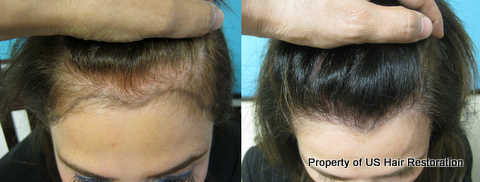 Parsa Mohebi, MD is among Los Angeles best hair restoration doctors. He notes that hair transplants are increasing among women. This includes scalp hair transplant for balding areas, improving the hairline to better frame the face and eyebrow hair transplants. As women continue to advance in the competitive workplace self image and confidence are playing an ever more critical role in their life. More and more women are seeking hair restoration options that will improve their self image and confidence that diminished with hair loss. Parsa Mohebi, MD is among Los Angeles best hair restoration doctors. He notes that hair transplants are increasing among women. This includes scalp hair transplant for balding areas, improving the hairline to better frame the face and eyebrow hair transplants. As women continue to advance in the competitive workplace self image and confidence are playing an ever more critical role in their life. More and more women are seeking hair restoration options that will improve their self image and confidence that diminished with hair loss.
Going bald adversely affects most people. Women often find it more traumatic then men. Hair defines significant quality of life issues for women including:
- her sense of personal beauty
- health and wellness
- sense of success and social status
- her sense of sexuality
- and other aspects of a woman’s self image and esteem.
Women are very devastated by the loss of hair. The best Los Angeles hair transplant centers are increasingly focusing on alleviating this problem for women. Men embarrassed about hair loss don’t like people to know that they have had a successful hair transplant. Unfair as it might be the social stigma for women with baldness is even greater. Hair loss is also associated with poor health to the general public. The confusion, fear, and anxiety and helplessness that women feel is completely understandable.
Advances in hair restoration technology and diagnosing female hair loss makes it easier to determine who can be successfully treated by a medical hair transplant.
Female Hair Transplant
A hair transplant offers an affordable natural, proven, and permanent solution for some woman. Los Angeles hair restoration doctors specializing in women’s hair loss have developed specific protocols in the management of female hair loss. Summer specials at leading hair restoration center US Hair Restorations makes this a great time to consider hair restoration. The latest and advanced technologies and developments in these medical procedures provide quality low cost hair transplants for women.
Tags: female hair loss, female hair transplant, hair transplant, women hair loss
Posted in Los Angeles Hair Transplant, Parsa Mohebi MD, women hair loss | 2 Comments »
Tuesday, February 21st, 2012
 We receive a lot of questions at US Hair Restoration about the use of Minoxidil (Rogaine), and how it affects hair growth after a hair transplant procedure. There are mixed reviews people find on the internet through different websites and blogs about the Foam version of Rogaine. Some say it helps hair growth, others say it hinders, while some claim it does absolutely nothing. We receive a lot of questions at US Hair Restoration about the use of Minoxidil (Rogaine), and how it affects hair growth after a hair transplant procedure. There are mixed reviews people find on the internet through different websites and blogs about the Foam version of Rogaine. Some say it helps hair growth, others say it hinders, while some claim it does absolutely nothing.
Minoxidil (Rogaine) may be used after a hair transplantation on the newly transplanted area, for protecting the already existing hairs which are genetically predisposed to thinning. The hair grafts which are actually transplanted from the donor area require no medication for growth and maintain a permanent residence in the balding area. Those are the healthy hairs which are not affected by the hormone DHT (Dehydrotestosterone) which causes thinning and baldness.
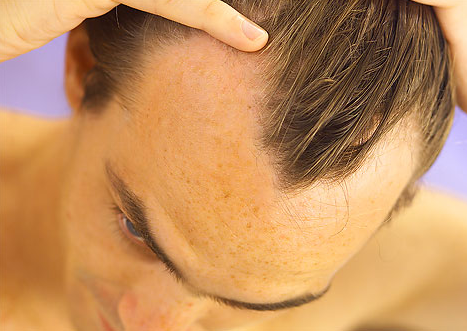 There may be some loss of existing native hair in the balding area due to shock loss, and for this we recommend Propecia for male patients to protect against. Propecia is proven to work better then Rogaine for the prevention of shock loss in men, and continues to have remarkable results in the patients who use the medication as directed. Unfortunately it does not work on women, but in these cases Rogaine does work and is a recommend option for the first few months after hair restoration surgery. There may be some loss of existing native hair in the balding area due to shock loss, and for this we recommend Propecia for male patients to protect against. Propecia is proven to work better then Rogaine for the prevention of shock loss in men, and continues to have remarkable results in the patients who use the medication as directed. Unfortunately it does not work on women, but in these cases Rogaine does work and is a recommend option for the first few months after hair restoration surgery.
Tags: female hair loss, finasteride, Male Hair Loss, minoxidil, propecia, rogaine, shock loss
Posted in after hair transplant, hair loss complications, hair loss medication, men hair restoration, women hair loss | No Comments »
Friday, January 20th, 2012
The fact is, we are genetically predisposed in many ways. Our physical makeup may favor one parent over another, but as we become more acquainted with different family members on both sides, we start to find common traits with various members from our families. Though one parental side may be more dominate over the other, our hair and the loss thereof, to a significant point, is also hereditary.

Perhaps you know someone who in their teens or early twenties started to experience thinning hair, the odds are the culprit is hidden in that complex of genetic code we call our ‘family tree.’
Hereditary hair loss is characterized by:
• Progressive miniaturization of hair follicles
• Shortening of the hair’s growth cycle
• The growth phase decreases
• Hair becomes thinner and shorter
• Eventually, the graft ceases to exist.
Modern Advances in hair restoration have made male-pattern and female-pattern androgenetic alopecia very treatable. Many men and women have enhanced their self image and esteem through successful hair restoration under the guidance of a highly skilled and qualified hair restoration medical doctor. MPB and FPB are common and today’s medical professionals have been paying attention the result being that both surgical and medical hair loss treatments have high rates of success.
Because hereditary hair loss is gradual, the sooner treatment is started, the better the chances of results. Checking your family tree to see if you have a possible genetic predisposition to hair loss might help you recognize the symptoms early enough to slow the progression.
Tags: alopecia, family history, Genetic Predispositions, hereditary hair loss
Posted in General Information, Hair Loss Conditions, Hair Loss Conversations, women hair loss | No Comments »
Friday, October 21st, 2011
 Hair loss and hair thinning is a result of testosterone formed in different areas like the prostate gland or hair follicles, which is converted to Dihydrotestosterone (DHT) in the scalp area. Hair follicles prone to genetic male patterned baldness contain DHT receptors, thus thinning hair and loss of hair can result. Over time men produce an abundance of DHT and the molecules affect their hair follicles and cause a decrease in size and eventually see their natural hair fall out permanently. Because of this common occurrence, hair loss in men is frequent. Hair loss and hair thinning is a result of testosterone formed in different areas like the prostate gland or hair follicles, which is converted to Dihydrotestosterone (DHT) in the scalp area. Hair follicles prone to genetic male patterned baldness contain DHT receptors, thus thinning hair and loss of hair can result. Over time men produce an abundance of DHT and the molecules affect their hair follicles and cause a decrease in size and eventually see their natural hair fall out permanently. Because of this common occurrence, hair loss in men is frequent.
DHT and hair loss from having the gene for male pattern baldness are the most common factors for male pattern baldness. Women suffering from female-pattern baldness, unlike their counterparts with male-pattern baldness, are not usually characterized by higher production rates of DHT from lower levels of testosterone. On the other hand, if for a number of possible reasons, a woman has increased testosterone, she can develop female patterned baldness like a man does through the same mechanism.
Hair in the prone areas to male patterned baldness: Corners, top, and crown are filled with DHT receptors in men who suffer Androgenic Alopecia The hair on donor areas such as back and sides, however, have fewer DHT receptors. This is precisely why hair is more permanent on the sides and back and not the top and front.
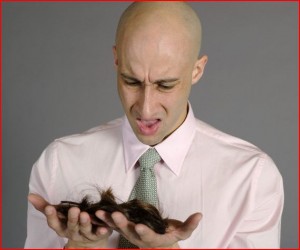
The distinction in the hair quality of different areas, such as the donor and recipient areas, allows for hair loss surgeons to remove the hair from one area and transplant it to the bald portions of the scalp. These newly transplanted hairs are permanent and immune to DHT. Finasteride (Propecia) is a drug which blocks the conversion of testosterone to DHT as a result of it blocking the enzyme alpha reductase. The amount of DHT in hair loss patients decrease when they are on Propecia and this helps to maintain healthy hair, and also helps some of the miniaturized hair become stronger.
We at US Hair Restoration often recommend medical treatment with DHT blockers in many of our patients who undergo a hair transplantation procedure in order to help maintain their own hair in addition to the newly restored, formerly balding areas because of a hair restoration surgery.
Tags: androgenetic alopecia, dht, DHT blockers, DHT receptors, dihydrotestosterone, female patterned baldness, finasteride, hair restoration surgery, propecia, testosteron
Posted in hair loss complications, Hair Loss Conditions, hair transplant, men hair restoration, women hair loss | No Comments »
Friday, March 4th, 2011
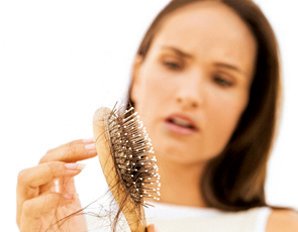 Many patients that come in to my office have a common complaint; hair shedding (some even bring in a ball of hair they have collected from their brush and bathroom floor) and in most cases they are women with long hair. For the most part hair shedding alone is not a sign of hair loss. Shedding is losing thick hair that has completed its growth phase and started its resting phase. Many patients that come in to my office have a common complaint; hair shedding (some even bring in a ball of hair they have collected from their brush and bathroom floor) and in most cases they are women with long hair. For the most part hair shedding alone is not a sign of hair loss. Shedding is losing thick hair that has completed its growth phase and started its resting phase.
- Examples of Normal Hair Shedding
All humans experience a level of hair shedding. It can be up to 100 to 200 hairs per day. Hair shedding is sometimes more exaggerated in people who have had a large surgery, trauma, experienced physiological or emotionally stressful events and women who have recently delivered a child. This is called Telogen Effluvium (excessive temporary loss of telogen hair). In most cases hair shedding is typically temporary and the affected hair will grow back within a few months. There is no cause for concern, unless you have a more visible scalp or thinning of the scalp hair. In which case, you should come in to see a certified hair restoration surgeon.
- The 3 Stages of Human Hair Growth
- Anagen ( Growing stage)
- Catagen (Transitional stage)
- Telogen ( Resting stage)
- Active Hair Loss Determined by Miniaturization Study
Almost every patient that visits US Hair Restoration will have a miniaturization study performed on them, to evaluate their degree of the fineness of their scalp hair which are signs of active hair loss, or in other words scalp hair miniaturization. People with active hair loss show 20-30% more thinning hair than the average person who experiences normal hair shedding. If you feel that you are experiencing active hair loss, we recommend you come into one of our five offices in California( San Francisco, San Diego, Orange County, Beverly Hills and Encino), for a free consultation.
Tags: active hair loss, free consultation, hair growth, hair loss, miniaturization study, normal hair shedding, resting phase, scalp hair miniaturization, telogen efflevium, us hair restoration
Posted in Beverly Hills hair transplant, California hair transplant, Orange County hair transplant, San Diego hair restoration, San Francisco Hair Transplant, Uncategorized, women hair loss | No Comments »
Thursday, November 18th, 2010
Hello blog readers,
I have some great news about US Hair Restoration’s current hair transplant costs!!
As the result of a recent meeting between my staff members and I, there will now be a Holiday Special beginning on December 1, 2010 at US Hair Restoration. This special will be offered for an extremely limited time and is one of the lowest prices for quality hair restoration yet.
We realize that holidays are quite busy for some people and that certain patients will need to book their procedure on a specific date in order to keep their schedules in tact. To accommodate this need of many of our patients, a rare discount of 40% off regular hair transplant costs will be offered to all of our valued clientele who have flexible schedules and are willing to book their procedures within 7-10 days of the procedure itself. By offering this discount to our patients with flexible schedules, we hope to accommodate the needs of all of our valued patients while not sacrificing the high quality that US hair Restoration stands by and is known for worldwide.
With this limited time discount, hair transplant costs at US Hair Restoration will be:
Offer only valid until January 31, 2011. Call 888-302-8747 to schedule your free consultation today. For additional information on the procedures we offer here at US Hair Restoration, feel free to check out our detailed webpages on Follicular Unit Transplants and Follicular Unit Extractions. We look forward to meeting you all in office soon!
Tags: cost of hair restoration, cost of hair transplant, hair restoration cost, hair transplant cost
Posted in Bakersfield hair transplant, California hair transplant, hair transplant, men hair restoration, Newport Beach hair transplant, Orange County hair transplant, San Diego hair restoration, san diego hair transplant, Uncategorized, women hair loss | No Comments »
Friday, January 1st, 2010
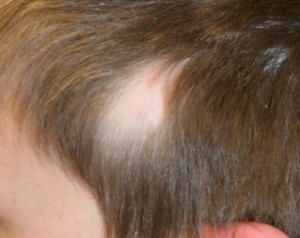
The other day, we just completed a hair transplant procedure with a child who has Congenital Temporal Alopecia (CTA). The day he was born, he had a bald patch on his head. It really weighed heavy on his mind and the thought of waiting until Christmas break (the time his parents had first planned to get it restored) was absolutely unbearable. The surgery was a success. We closely packed 470 follicular unit grafts onto the bald patch of his temple area. He’s really excited and anticipates the final growth of his hair grafts in the next several months.
Congenital Temporal Alopecia is a hair loss condition which is present at birth and takes the form of a patchy hair loss on a child’s temple area of the head. The bald patch can be made up of very fine hair. It’s a non-scarring type of alopecia which, reportedly, responds rather positively to hair transplant surgery.
Tags: alopeica, congenital temporal triangular alopecia, non scarring alopecia, patchy hair loss, TTA
Posted in men hair restoration, Uncategorized, women hair loss | No Comments »
|
|


 Hair goes through a cycling phase, where a hair shaft falls and after a few weeks another one begins to grow from the same follicle. In most cases the cycle won’t pass 20% of the hair shafts in any area. Hair loss will become active because the follicles of the hair go through a growth cycle. During the growth cycle process, there are resting intervals where the hairs slowly start to get thinner and miniaturization occurs. Only a small percentage of the hairs will be in resting phase. Miniaturization occurs when the hair shaft is no longer as thick as it was before. At that time the hairs become very thin and it is not seen to the naked eye.
Hair goes through a cycling phase, where a hair shaft falls and after a few weeks another one begins to grow from the same follicle. In most cases the cycle won’t pass 20% of the hair shafts in any area. Hair loss will become active because the follicles of the hair go through a growth cycle. During the growth cycle process, there are resting intervals where the hairs slowly start to get thinner and miniaturization occurs. Only a small percentage of the hairs will be in resting phase. Miniaturization occurs when the hair shaft is no longer as thick as it was before. At that time the hairs become very thin and it is not seen to the naked eye. SMP- scalp micro pigmentation is a cosmetic hair restoration procedure where the patients scalp is tatooed with ink to create the illusion of shaved hair or hair stubble. This is a method sometimes preferred by bald men who are seeking an alternative to hair transplant surgery or to augment hair transplant surgery. Performed correctly SMP provides the appearance of short shaved hair to balding areas of the scalp. Like any cosmetic medical procedure the results are only as good as the surgeon performing the procedure.
SMP- scalp micro pigmentation is a cosmetic hair restoration procedure where the patients scalp is tatooed with ink to create the illusion of shaved hair or hair stubble. This is a method sometimes preferred by bald men who are seeking an alternative to hair transplant surgery or to augment hair transplant surgery. Performed correctly SMP provides the appearance of short shaved hair to balding areas of the scalp. Like any cosmetic medical procedure the results are only as good as the surgeon performing the procedure. 



 Hair loss and hair thinning is a result of testosterone formed in different areas like the prostate gland or hair follicles, which is converted to Dihydrotestosterone (DHT) in the scalp area. Hair follicles prone to genetic male patterned baldness contain DHT receptors, thus thinning hair and loss of hair can result. Over time men produce an abundance of DHT and the molecules affect their hair follicles and cause a decrease in size and eventually see their natural hair fall out permanently. Because of this common occurrence, hair loss in men is frequent.
Hair loss and hair thinning is a result of testosterone formed in different areas like the prostate gland or hair follicles, which is converted to Dihydrotestosterone (DHT) in the scalp area. Hair follicles prone to genetic male patterned baldness contain DHT receptors, thus thinning hair and loss of hair can result. Over time men produce an abundance of DHT and the molecules affect their hair follicles and cause a decrease in size and eventually see their natural hair fall out permanently. Because of this common occurrence, hair loss in men is frequent.


